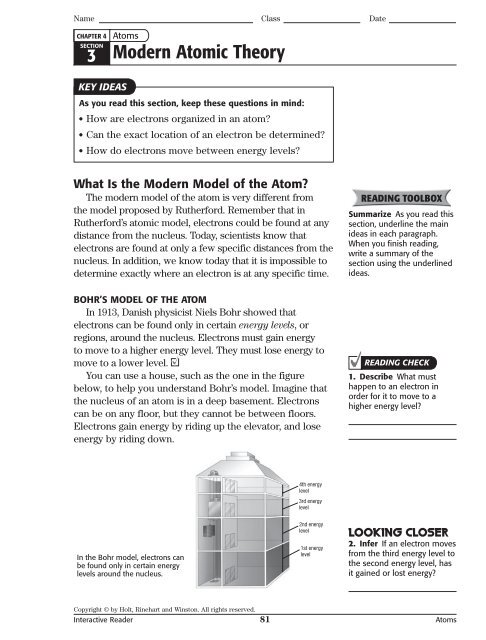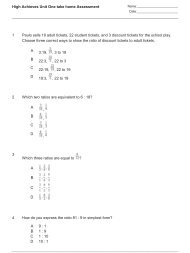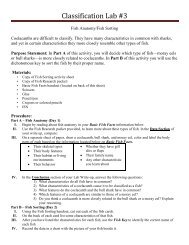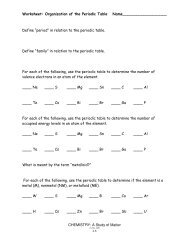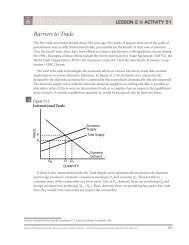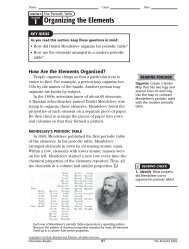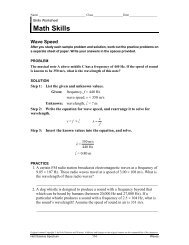Create successful ePaper yourself
Turn your PDF publications into a flip-book with our unique Google optimized e-Paper software.
Name Class DateSECTION 3Modern Atomic Theory continuedHow Do Electrons Fill Energy Levels?Within an atom, electrons have different amounts ofenergy and exist in different energy levels. Recall that thereare many possible energy levels in an atom. Each energylevel can hold a specific number of electrons. For example,the first energy level can hold up to two electrons. The moreelectrons an atom has, the more energy levels are “filled.”The figure below shows how many electrons differentenergy levels can hold.Electrons fill energy levels in order from lowest energyto highest energy. For example, lithium atoms have threeelectrons. Two of the electrons fill the first energy level. Thethird electron is located in the second energy level.6. Infer How is the modernatomic model similar to Bohr’smodel of the atom?Electron Energy Levels32e –Energy level 4Energy level 38e –Energy level 22e – Energy level 118e –Each energy level canhold a different numberof electrons.7. Describe An atomcontains nine electrons. Inwhich energy levels are theelectrons located?The electrons in the outer energy level of an atom arecalled valence electrons. Valence electrons determine thechemical properties of an atom. For example, all atoms withone valence electron behave in a similar way.Each energy level contains one or more subshells.There are four different kinds of subshells. Each kind ofsubshell is represented by a different letter: s, p, d, or f.Each subshell has a different shape.The lower the energy level, the fewer subshells are in theenergy level. For example, the first energy level containsonly an s subshell. The third energy level contains s, p, andd subshells.Each subshell contains one or more orbitals. Each orbitalcan hold up to two electrons. An s subshell contains onlyone orbital, so it can hold up to two electrons.A p subshell contains three orbitals, as shown in the figureson the next page. The different orbitals have differentorientations, or directions, in space. Each orbital can holdup to two electrons. Therefore, the three orbitals in thep subshell together can hold up to six electrons.READING CHECK8. Define What are valenceelectrons?READING CHECK9. Describe How manyelectrons can an s subshellhold?Copyright © by Holt, Rinehart and Winston. All rights reserved.<strong>Interactive</strong> Reader 83 Atoms
Name Class DateSECTION 3Modern Atomic Theory continuedyyy10. Compare How are thethree p orbitals different fromone another?zxzxzxThere are three kinds of p orbitals.The shapes of the d and f orbitals are very complex. Itis very difficult to show them in a drawing. There are fivedifferent kinds of d orbitals. Therefore, all the d orbitalstogether can hold up to ten electrons. There are sevendifferent kinds of f orbitals, so all the f orbitals together canhold up to 14 electrons.Discuss It can be difficult tounderstand energy levels andorbitals. After you read aboutenergy levels and orbitals,discuss any questions youhave with a small group.11. Describe An atom haselectrons in the first andsecond energy levels. Whatis the greatest number ofelectrons it could have?ELECTRONS AND ORBITALSEvery energy level contains a certain number oforbitals. Each orbital can hold two electrons. Therefore,the number of orbitals determines the total number ofelectrons in that energy level. For instance, the secondenergy level of an atom has four orbitals: one s orbitaland three p orbitals. Therefore, the second energy levelcan hold up to eight electrons. The figure below showsthe maximum number of electrons in each energy level.EnergylevelNumber oforbitals by types p d fTotal numberof orbitals1 1 1 22 1 3 1 + 3 = 4 83 1 3 5 1 + 3 + 5 = 9 184 1 3 5 7 1 + 3 + 5 + 7 = 16 32Maximumnumber ofelectronsHow Can Electrons Move in an Atom?An electron is never found between energy levels.Instead, it “jumps” from one level to the next. Whatmakes an atom move from one energy level to another?Electrons move between energy levels when an atomgains or loses energy.Copyright © by Holt, Rinehart and Winston. All rights reserved.<strong>Interactive</strong> Reader 84 Atoms
Name Class DateSECTION 3Modern Atomic Theory continuedGROUND STATE AND EXCITED STATEThe lowest state of energy of an electron is called itsground state. When an electron gains energy, it moves toan excited state in a higher energy level. Electrons gainenergy by absorbing photons. A photon is the smallestunit of light energy. It is a little bit like an atom of light.When an electron falls to a lower energy level, it releasesone photon.Photons have different energies. The energy of thephoton affects which energy level an electron can moveto. The higher the energy of the photon, the higher theenergy level the electron can jump to.READING CHECK12. Define What is theground state of an electron?Photon isabsorbedKey:Electron Energy levelWhen an electron absorbs a photon, the electron can jump to ahigher energy level.13. Identify On the figure,label the correct illustrationswith “ground state” or“excited state.”ATOMS AND LIGHTThe energy of a photon is related to the wavelength ofthe light. Atoms of a given element can only gain or loseenergy in specific amounts. These amounts of energycorrespond to light of certain wavelengths, or colors.Therefore, the colors of light that are emitted or absorbedby an element can be used to identify the element.For example, neon signs use energy from electricityto excite atoms of neon gas. The atoms of neon first gainthe energy and then release it in the form of light. Thewavelength of visible light determines the color of light.Fireworks are another example. The colors of fireworksare produced by burning compounds of magnesium,aluminum, and sodium salts.Copyright © by Holt, Rinehart and Winston. All rights reserved.<strong>Interactive</strong> Reader 85 Atoms
Name Class DateSection 3 ReviewSECTION VOCABULARYorbital a region in an atom where there is ahigh probability of finding electronsphoton a unit or quantum of light; a particle ofelectromagnetic radiation that has zero restmass and carries a quantum of energyvalence electron an electron that is found in theoutermost shell of an atom and that determinesthe atom’s chemical properties1. Apply Concepts An atom’s valence electrons are in the second energy level. Whichtwo orbitals could the valence electrons be in?2. Describe Relationships How are energy levels and orbitals related?3. Describe An atom of nitrogen contains seven electrons. Describe the number ofelectrons in each energy level in an atom of nitrogen.4. Infer How many valence electrons does an atom of nitrogen have? Explain youranswer.5. Explain According to the modern atomic theory, what can scientists not knowabout an electron?6. Apply Concepts Aluminum has an atomic number of 13. In which energy levels arethe electrons in an aluminum atom? (Hint: Remember that atoms have the samenumber of electrons as protons.)7. Identify How many valence electrons does an atom of aluminum have? Explainyour answer.Copyright © by Holt, Rinehart and Winston. All rights reserved.<strong>Interactive</strong> Reader 86 Atoms


